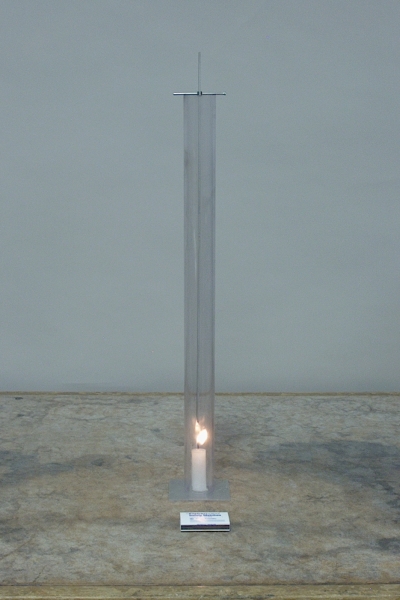

A small plate holds a candle, which is secured by a protruding nail. Light the candle, and then place the transparent plastic tube, with the long metal plate inside it, over the candle as shown in the photograph. The candle burns as long as you leave the plate in. Now lift the metal plate out of the tube. As you lift the plate, the candle flame begins to weaken, and by the time you have removed the plate, or not long after, it goes out. (Be careful to center the tube on the candle, and not to leave the candle burning too long; after a while, the tube gets hot.)
A candle flame heats the surrounding air, which thus becomes less dense and rises and is replaced with air from the sides and below. This allows the flame to have a steady supply of oxygen so that it keeps burning. If you place a tube over the burning candle (without anything inside the tube), this heating of the air near the flame creates an updraft, except that air cannot enter from the bottom of the tube, which sits flush with the plate that holds the candle. Air from above cannot get past the plug of hotter air rising from the candle. There is thus no air flow, and the flame eventually consumes all the oxygen in the air nearby, after which it goes out.
If you place a long strip of metal inside the tube, it divides the tube so that air heated by the candle flame can rise up one side of the plate, and cooler air from above can flow downward along the other side of the plate, setting up a convection current. This keeps a steady supply of oxygen flowing to the flame, so that it keeps burning.
The bottom of the long metal plate should hang about two inches above the wick of the candle. You can adjust this height by placing the blunted finishing nail, which is secured by two small o-rings, through the appropriate hole in the plate.
In case there is any doubt regarding the nature of the convection current set up by having the plate inside the tube, the rising hot air carries soot from the candle flame, some of which is deposited on the metal plate. Because of this, each side of the plate has a soot streak. On one side, this streak runs almost the entire length of the plate, but on the other side, it runs only a few inches from the bottom. This shows fairly clearly that the convection current is as described above.